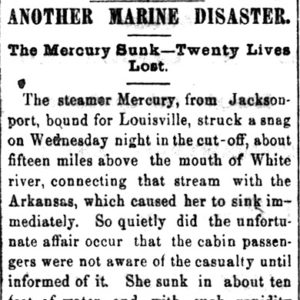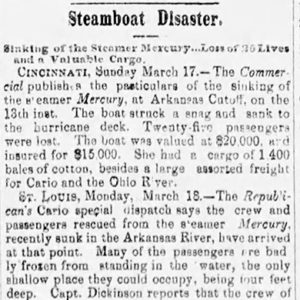calsfoundation@cals.org
Mercury [Steamboat]
The Mercury was a sternwheel river packet that struck a snag in the White River on March 13, 1867, and sank, killing several people, as well as more than 200 mules being transported on the vessel.
The Mercury was a 184-ton sternwheel paddleboat built in Brownsville, Pennsylvania, in 1862. The steamboat was used as a troop transport and supply vessel during the Civil War, being chartered the majority of the time between July 1863 through the cessation of hostilities in 1865. The vessel was beached and then sunk near St. Louis in May 1865 after colliding with another steamer, the Hard Times. The Mercury’s cargo of wounded soldiers was successfully transferred to the Hard Times after the accident; the vessel was repaired and served the Union until December 1865.
Following the war, the Mercury regularly plied the waters of the Ohio River, but by November 1866, the steamboat, under the command of Captain George Dickenson with a forty-man crew, was running a route between Memphis, Tennessee, and the White River in Arkansas. On March 13, 1867, the vessel was taking the White River Cutoff, which had been successfully traversed by a Union fleet for the Battle of Arkansas Post, on its return downriver from a run to Jacksonport (Jackson County) with thirty-three passengers and a cargo that included around 210 mules and 1,400 bales of cotton. It was a dark night complicated by a blinding snowstorm, and the Mercury hit a snag.
The steamboat sank rapidly to the level of its hurricane deck. Some crew members escaped on the boat’s yawl, and seven men clung to a floating cotton bale, four of whom died when a tree toppled by the storm struck them. Others drowned, and surviving passengers were forced to stand in about four feet of icy water as they awaited rescue.
One passenger later wrote in the Memphis Daily Appeal that people from Napoleon (Desha County) called on the captain of the steamboat St. Patrick to go to the Mercury’s assistance, but he declined, claiming his boat was overloaded. The Napoleon residents tried to steam to the wreck in a tugboat, but that vessel was soon disabled. Finally, at about 3:00 a.m. on March 14, the steamboat George D. Palmer arrived, the passenger wrote, and rescued the survivors.
It is unclear how many people died in the sinking of the Mercury; the passenger stated in his letter to the Appeal that “only five or six persons were lost, and they were frozen.” Many of those who survived the sinking suffered from frostbite after standing in the frigid waters. The cargo of mules was drowned, and much of the cotton lost.
Though the Appeal correspondent praised the captain and crew of the George D. Palmer as saviors, Dickenson alleged that they robbed the survivors and rifled their luggage—“and even the underclothes of the ladies and boots and shirts of the men were stolen.” The Palmer’s officers responded with a card in the Louisville Courier-Journal that the accusations were “maliciously false.” The Arkansas Gazette published a notice on March 29, 1867, stating: “Reports that the crew of the steamer Geo. D. Palmer were guilty of robbing the passengers of the ill-fated steamer Mercury were false. The robbing was perpetrated by the crew of the Mercury before Palmer reached the scene. We are authorized by the officers of the Palmer to make this statement.”
The Mercury was valued at $20,000 and was insured for $15,000. The insurance company hired Captain Reese Dugan of the salvage vessel Underwriter to raise the wreck, which still held around 160 bales of cotton. While press reports did not reveal whether the operation was successful, one newspaper stated that Dugan “has raised more sunken steamboats than all the wrecking institutions on the Western waters combined” and another reported that “it is an even bet that ‘Reese’ succeeds.”
One collateral casualty of the Mercury sinking was a Mr. Murphy of Memphis, who owned the mules that perished in the accident. His remaining livestock were sold at auction commencing on April 9, 1867, with Murphy “having some liabilities to meet [was] compelled to sell out to the highest bidder for cash.”
For additional information:
“Another Marine Disaster.” Memphis Public Ledger, March 16, 1867, p. 3.
“Another River Disaster.” Memphis Daily Appeal, March 17, 1867, p. 3.
Arkansas Gazette, March 29, 1867, p. 3.
“The Geo. D. Palmer and the Sinking of the Mercury.” Louisville Courier-Journal, April 9, 1867, p. 3.
Gibson, Charles Dana, and E. Kay Gibson, comps. Dictionary of Transports and Combatant Vessels, Union Army, 1861–1868. Camden, ME: Ensign Press, 1995.
“Mules at Auction” [Advertisement]. Memphis Public Ledger, April 11, 1867, p. 2.
“River Matters.” Memphis Daily Appeal, March 26, 1867, p. 3.
“River News.” Louisville Daily Courier, April 10, 1867, p. 4.
“Steamboat Disaster.” Burlington [Vermont] Weekly Sentinel, March 22, 1867, p. 2.
St. Louis Daily Missouri Republican, April 13, 1867, p. 4.
Way, Frederick, Jr. Way’s Packet Directory. Athens, OH: Ohio University Press, 1983.
Mark K. Christ
Central Arkansas Library System
 Civil War through Reconstruction, 1861 through 1874
Civil War through Reconstruction, 1861 through 1874 Transportation
Transportation Mercury Steamboat Article
Mercury Steamboat Article  Mercury Steamboat Article
Mercury Steamboat Article 




Comments
No comments on this entry yet.